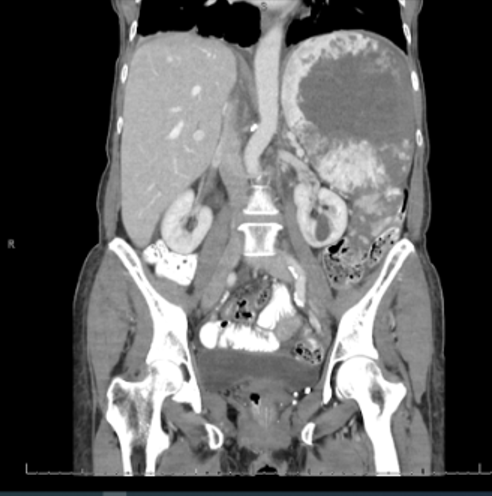Tuesday Poster Session
Category: Stomach and Spleen
P6405 - Refractory Gastric Bleeding From Y-90 Radiotherapy in a Patient With Splenic Angiosarcoma
Tuesday, October 28, 2025
10:30 AM - 4:00 PM PDT
Location: Exhibit Hall

Yordan A. Urrutia, MD
University of South Florida Morsani College of Medicine
Tampa, FL
Presenting Author(s)
Yordan A. Urrutia, MD, Susan Jacob, MD, Jason Colizzo, MD
University of South Florida Morsani College of Medicine, Tampa, FL
Introduction: Splenic angiosarcoma is rare aggressive vascular neoplasm with a mean survival of 12-24 months after diagnosis.1 Treatment modalities include resection, chemotherapy, and radiation therapy; each associated with possible complications. Reports of gastrointestinal (GI) bleeding associated with splenic angiosarcomas are rare but can occur in metastasis to the GI tract or side effects of treatment.2- 4. This report highlights the case of a 73-year-old woman with a large splenic angiosarcoma with refractory gastrointestinal bleeding from radiation gastritis following yttrium-90 (Y-90) radioembolization.
Case Description/
Methods: 73-year-old woman with a large splenic angiosarcoma with metastases to the bone, liver, and lungs status-post Y-90 radiotherapy presented to the emergency department with melena and symptomatic anemia for 3 weeks. She was hemodynamically stable with splenomegaly on exam. Labs revealed a hemoglobin of 5.8. CT imaging of the abdomen and pelvis revealed a large necrotic mass involving most of the spleen measuring up to 21cm (image 1).
Esophagogastroduodenoscopy (EGD) revealed compression of the gastric cardia region from the splenic mass (image 2). There was gastric friability and numerous angiectasias in the proximal gastric body and fundus regions which bled upon contact. Treatment was attempted with argon plasma coagulation (APC) and radiofrequency ablation (RFA); each with suboptimal hemostasis. Hemospray was subsequently utilized with immediate hemostasis. Biopsies of the area were negative for dysplasia, but did reveal radiation-induced gastropathy with notable black spheres present in vascular channels; consistent with Y-90 microsphere therapy.
Discussion: Y-90 radioembolization utilizes yttrium-labeled microspheres to induce necrosis in malignant lesions such as hepatocellular carcinoma or angiosarcoma. It is a minimally invasive technique but can be associated with various GI complications including emesis, cholecystitis, or even GI bleeding such as in our patient. Y-90 radiotherapy-associated gastric bleeding is a relatively rare complication seen in approximately 2% of patients.5 Gastric ulceration is the most common etiology and standard endoscopic therapies can be attempted; however, there is no consensus on optimal management. In this patient’s case topical hemostatic therapy (hemospray) was ultimately successful in achieving immediate hemostasis. She is currently under close endoscopic surveillance and clinical monitoring.

Figure: Image 1. CT image demonstrating large 15 cm by 10 cm by 21 cm necrotic mass involving most of the spleen.

Figure: Image 2. A: Compression of gastric cardia region from splenic mass. B: Numerous angioectasias with bleeding upon superficial contact at the fundus and proximal gastric body.
Disclosures:
Yordan Urrutia indicated no relevant financial relationships.
Susan Jacob indicated no relevant financial relationships.
Jason Colizzo indicated no relevant financial relationships.
Yordan A. Urrutia, MD, Susan Jacob, MD, Jason Colizzo, MD. P6405 - Refractory Gastric Bleeding From Y-90 Radiotherapy in a Patient With Splenic Angiosarcoma, ACG 2025 Annual Scientific Meeting Abstracts. Phoenix, AZ: American College of Gastroenterology.
University of South Florida Morsani College of Medicine, Tampa, FL
Introduction: Splenic angiosarcoma is rare aggressive vascular neoplasm with a mean survival of 12-24 months after diagnosis.1 Treatment modalities include resection, chemotherapy, and radiation therapy; each associated with possible complications. Reports of gastrointestinal (GI) bleeding associated with splenic angiosarcomas are rare but can occur in metastasis to the GI tract or side effects of treatment.2- 4. This report highlights the case of a 73-year-old woman with a large splenic angiosarcoma with refractory gastrointestinal bleeding from radiation gastritis following yttrium-90 (Y-90) radioembolization.
Case Description/
Methods: 73-year-old woman with a large splenic angiosarcoma with metastases to the bone, liver, and lungs status-post Y-90 radiotherapy presented to the emergency department with melena and symptomatic anemia for 3 weeks. She was hemodynamically stable with splenomegaly on exam. Labs revealed a hemoglobin of 5.8. CT imaging of the abdomen and pelvis revealed a large necrotic mass involving most of the spleen measuring up to 21cm (image 1).
Esophagogastroduodenoscopy (EGD) revealed compression of the gastric cardia region from the splenic mass (image 2). There was gastric friability and numerous angiectasias in the proximal gastric body and fundus regions which bled upon contact. Treatment was attempted with argon plasma coagulation (APC) and radiofrequency ablation (RFA); each with suboptimal hemostasis. Hemospray was subsequently utilized with immediate hemostasis. Biopsies of the area were negative for dysplasia, but did reveal radiation-induced gastropathy with notable black spheres present in vascular channels; consistent with Y-90 microsphere therapy.
Discussion: Y-90 radioembolization utilizes yttrium-labeled microspheres to induce necrosis in malignant lesions such as hepatocellular carcinoma or angiosarcoma. It is a minimally invasive technique but can be associated with various GI complications including emesis, cholecystitis, or even GI bleeding such as in our patient. Y-90 radiotherapy-associated gastric bleeding is a relatively rare complication seen in approximately 2% of patients.5 Gastric ulceration is the most common etiology and standard endoscopic therapies can be attempted; however, there is no consensus on optimal management. In this patient’s case topical hemostatic therapy (hemospray) was ultimately successful in achieving immediate hemostasis. She is currently under close endoscopic surveillance and clinical monitoring.

Figure: Image 1. CT image demonstrating large 15 cm by 10 cm by 21 cm necrotic mass involving most of the spleen.

Figure: Image 2. A: Compression of gastric cardia region from splenic mass. B: Numerous angioectasias with bleeding upon superficial contact at the fundus and proximal gastric body.
Disclosures:
Yordan Urrutia indicated no relevant financial relationships.
Susan Jacob indicated no relevant financial relationships.
Jason Colizzo indicated no relevant financial relationships.
Yordan A. Urrutia, MD, Susan Jacob, MD, Jason Colizzo, MD. P6405 - Refractory Gastric Bleeding From Y-90 Radiotherapy in a Patient With Splenic Angiosarcoma, ACG 2025 Annual Scientific Meeting Abstracts. Phoenix, AZ: American College of Gastroenterology.
